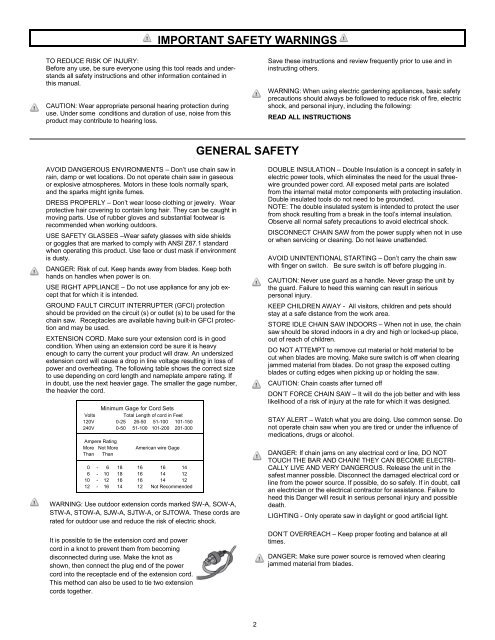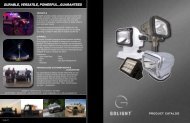Electric Chain Saw CS30014 CS30016.pdf - Dorian Drake ...
Electric Chain Saw CS30014 CS30016.pdf - Dorian Drake ...
Electric Chain Saw CS30014 CS30016.pdf - Dorian Drake ...
Create successful ePaper yourself
Turn your PDF publications into a flip-book with our unique Google optimized e-Paper software.
TO REDUCE RISK OF INJURY:<br />
Before any use, be sure everyone using this tool reads and understands<br />
all safety instructions and other information contained in<br />
this manual.<br />
CAUTION: Wear appropriate personal hearing protection during<br />
use. Under some conditions and duration of use, noise from this<br />
product may contribute to hearing loss.<br />
AVOID DANGEROUS ENVIRONMENTS – Don’t use chain saw in<br />
rain, damp or wet locations. Do not operate chain saw in gaseous<br />
or explosive atmospheres. Motors in these tools normally spark,<br />
and the sparks might ignite fumes.<br />
DRESS PROPERLY – Don’t wear loose clothing or jewelry. Wear<br />
protective hair covering to contain long hair. They can be caught in<br />
moving parts. Use of rubber gloves and substantial footwear is<br />
recommended when working outdoors.<br />
USE SAFETY GLASSES –Wear safety glasses with side shields<br />
or goggles that are marked to comply with ANSI Z87.1 standard<br />
when operating this product. Use face or dust mask if environment<br />
is dusty.<br />
DANGER: Risk of cut. Keep hands away from blades. Keep both<br />
hands on handles when power is on.<br />
USE RIGHT APPLIANCE – Do not use appliance for any job except<br />
that for which it is intended.<br />
GROUND FAULT CIRCUIT INTERRUPTER (GFCI) protection<br />
should be provided on the circuit (s) or outlet (s) to be used for the<br />
chain saw. Receptacles are available having built-in GFCI protection<br />
and may be used.<br />
EXTENSION CORD. Make sure your extension cord is in good<br />
condition. When using an extension cord be sure it is heavy<br />
enough to carry the current your product will draw. An undersized<br />
extension cord will cause a drop in line voltage resulting in loss of<br />
power and overheating. The following table shows the correct size<br />
to use depending on cord length and nameplate ampere rating. If<br />
in doubt, use the next heavier gage. The smaller the gage number,<br />
the heavier the cord.<br />
Minimum Gage for Cord Sets<br />
Volts Total Length of cord in Feet<br />
120V 0-25 26-50 51-100 101-150<br />
240V 0-50 51-100 101-200 201-300<br />
Ampere Rating<br />
More Not More American wire Gage<br />
Than Than<br />
0 - 6 18 16 16 14<br />
6 - 10 18 16 14 12<br />
10 - 12 16 16 14 12<br />
12 - 16 14 12 Not Recommended<br />
WARNING: Use outdoor extension cords marked SW-A, SOW-A,<br />
STW-A, STOW-A, SJW-A, SJTW-A, or SJTOWA. These cords are<br />
rated for outdoor use and reduce the risk of electric shock.<br />
It is possible to tie the extension cord and power<br />
cord in a knot to prevent them from becoming<br />
disconnected during use. Make the knot as<br />
shown, then connect the plug end of the power<br />
cord into the receptacle end of the extension cord.<br />
This method can also be used to tie two extension<br />
cords together.<br />
IMPORTANT SAFETY WARNINGS<br />
GENERAL SAFETY<br />
2<br />
Save these instructions and review frequently prior to use and in<br />
instructing others.<br />
WARNING: When using electric gardening appliances, basic safety<br />
precautions should always be followed to reduce risk of fire, electric<br />
shock, and personal injury, including the following:<br />
READ ALL INSTRUCTIONS<br />
DOUBLE INSULATION – Double Insulation is a concept in safety in<br />
electric power tools, which eliminates the need for the usual threewire<br />
grounded power cord. All exposed metal parts are isolated<br />
from the internal metal motor components with protecting insulation.<br />
Double insulated tools do not need to be grounded.<br />
NOTE: The double insulated system is intended to protect the user<br />
from shock resulting from a break in the tool’s internal insulation.<br />
Observe all normal safety precautions to avoid electrical shock.<br />
DISCONNECT CHAIN SAW from the power supply when not in use<br />
or when servicing or cleaning. Do not leave unattended.<br />
AVOID UNINTENTIONAL STARTING – Don’t carry the chain saw<br />
with finger on switch. Be sure switch is off before plugging in.<br />
CAUTION: Never use guard as a handle. Never grasp the unit by<br />
the guard. Failure to heed this warning can result in serious<br />
personal injury.<br />
KEEP CHILDREN AWAY - All visitors, children and pets should<br />
stay at a safe distance from the work area.<br />
STORE IDLE CHAIN SAW INDOORS – When not in use, the chain<br />
saw should be stored indoors in a dry and high or locked-up place,<br />
out of reach of children.<br />
DO NOT ATTEMPT to remove cut material or hold material to be<br />
cut when blades are moving. Make sure switch is off when clearing<br />
jammed material from blades. Do not grasp the exposed cutting<br />
blades or cutting edges when picking up or holding the saw.<br />
CAUTION: <strong>Chain</strong> coasts after turned off<br />
DON’T FORCE CHAIN SAW – It will do the job better and with less<br />
likelihood of a risk of injury at the rate for which it was designed.<br />
STAY ALERT – Watch what you are doing. Use common sense. Do<br />
not operate chain saw when you are tired or under the influence of<br />
medications, drugs or alcohol.<br />
DANGER: If chain jams on any electrical cord or line, DO NOT<br />
TOUCH THE BAR AND CHAIN! THEY CAN BECOME ELECTRI-<br />
CALLY LIVE AND VERY DANGEROUS. Release the unit in the<br />
safest manner possible. Disconnect the damaged electrical cord or<br />
line from the power source. If possible, do so safely. If in doubt, call<br />
an electrician or the electrical contractor for assistance. Failure to<br />
heed this Danger will result in serious personal injury and possible<br />
death.<br />
LIGHTING - Only operate saw in daylight or good artificial light.<br />
DON’T OVERREACH – Keep proper footing and balance at all<br />
times.<br />
DANGER: Make sure power source is removed when clearing<br />
jammed material from blades.




